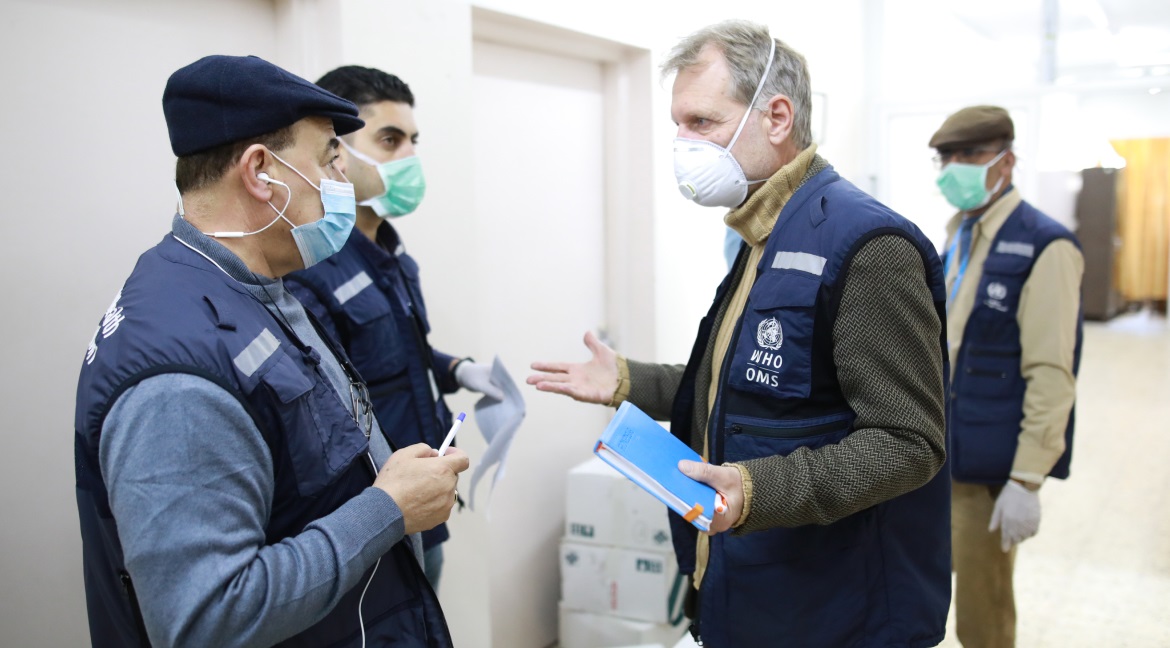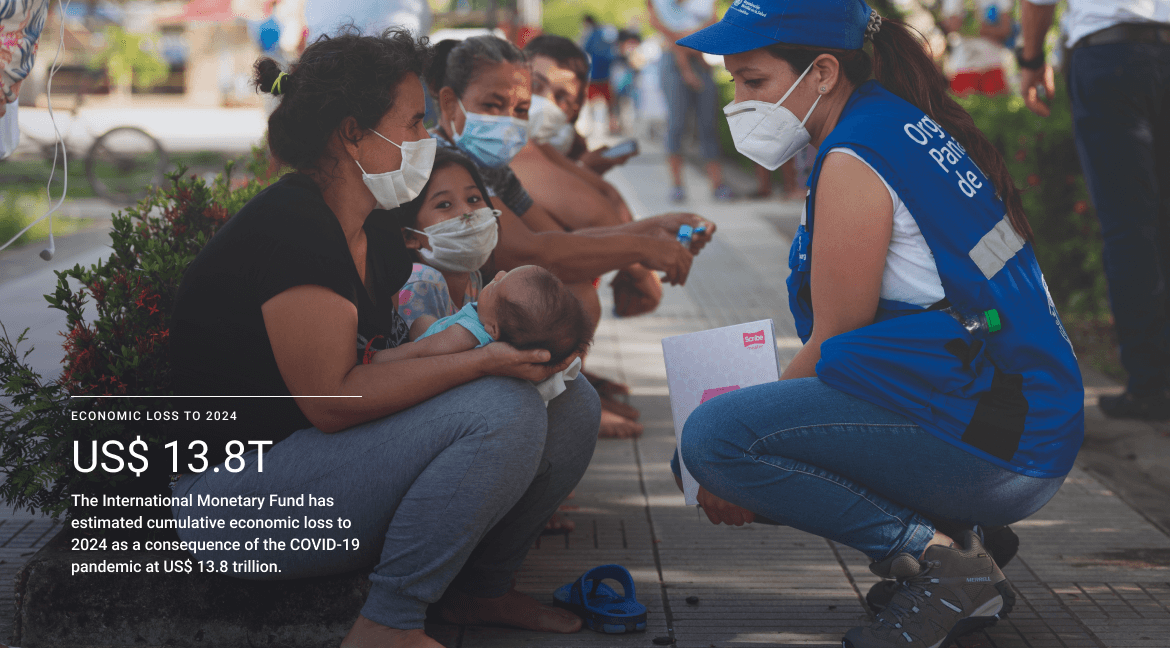
Chapter 2
Current context: the COVID-19 pandemic and continuing challenges to global health
Current context: the COVID-19 pandemic and continuing challenges to global health
This investment case comes at an extraordinary time in global health. The COVID-19 pandemic is the most extreme combined health and economic crisis in the last century.
It represents the most significant health challenge that the world has confronted in over 70 years of WHO’s existence. There is therefore an unprecedented level of both scrutiny and opportunity for change in relation to global health, as awareness of the consequences of a new pandemic disease and its ramifications across all areas of life are at the forefront of this health emergency. The pandemic has sharply focused policy attention but it is just one of the many challenges to which global health must respond, along with climate change and its ramifications, the growing problem of antimicrobial resistance, the unfinished Millennium Development Goal health-related agenda of HIV, tuberculosis and malaria, and the consequences of urbanization and threats to environmental and animal health which require a coordinated “one health” response.
The global toll of COVID-19 has been massive. By the end of 2021 there were reports of more than 282 million cumulative confirmed cases and 5.4 million deaths, with these numbers almost certainly a major underestimation of the true extent of cases and deaths.1 Successive waves of the pandemic have put health systems under enormous pressure in both wealthy and resource-constrained countries. As well as increased patient loads, health workers themselves have been at the frontlines of exposure to SARS-CoV-2 and WHO estimates that 116 000 health workers lost their lives to COVID-19 between January 2020 and May 2021.2
Indirect health impacts have also resulted from the disruptions to livelihoods, education and social protection consequent on the pandemic. The International Monetary Fund has estimated cumulative economic loss to 2024 as a consequence of the pandemic at US$ 13.8 trillion.3 The pandemic has set back progress towards the Sustainable Development Goals by decades, across all areas.4 This impact has not been felt equally, with the most vulnerable and disadvantaged people most immediately affected and suffering the most lasting damage, as child labour rates have risen, girls have missed out disproportionately on schooling and risks of early marriage have increased, gender-based violence has exploded, and inequality has risen with a 6% increase predicted in the Gini coefficient in emerging and developing country economies.5

The new pandemic created huge demand for rapidly available, trusted scientific advice. WHO responded to the challenge by establishing a new fast-track review mechanism in crucial areas of COVID-19 response in order to ensure the coherence and quality of interim guidance and other outputs. It provided approval or critique to WHO technical teams within 24 to 48 hours, and reviewed more than 1000 documents in the first 18 months of the pandemic. WHO has dispatched missions in response to requests from countries around the globe, supported country intra-action reviews to learn from and improve the response, and worked with 23 partners in the United Nations system in a coordinated United Nations system response. In addition to the direct pandemic response, WHO has been a trusted partner in many countries in ensuring continuity in essential health service delivery.
The experience of the last two years has highlighted the centrality of primary health care to pandemic recovery.6 WHO’s Special Programme on Primary Health Care was launched in 2020 as part of the Organization’s transformation agenda and its building blocks include the Universal Health Coverage Partnership and strengthened systems for health financing, health care workforce, medicines and technologies, data and health information. Primary health care connects the Triple Billion targets, reinforcing health systems, essential public health functions and multisectoral policy approaches. Integral to stronger and more effective primary health care is the promotion of health equity, human rights and community empowerment.


WHO has stepped up its efforts across all its areas of activity in response to the COVID-19 pandemic. Every area of health has felt the impact of the pandemic directly or indirectly. Every level of WHO - global, regional and country - has delivered at a greater level of intensity than ever before in the Organization’s history. Although this context has posed enormous challenges, it has also created greater clarity in understanding the needs for, and benefits of, investment in WHO. Internal and external reviews of WHO’s performance in pandemic preparedness and response have been undertaken in the context of the COVID-19 pandemic and their results have unanimously called for funding for the WHO Health Emergencies Programme to be increased as well as for more flexible and sustained funding for WHO as a whole.
The pandemic has underscored the dangers of underinvesting in pandemic preparedness, revealing major country-level gaps in surveillance and pandemic intelligence, fundamental health system capacities such as case detection and isolation, and leadership and national coordination capacities. When the pandemic struck, major regional and global gaps in pre-positioned emergency supplies, surge workforce capacities, and coordination structures exacerbated national vulnerabilities.

- The true death toll of COVID-19: estimating global excess mortality. Geneva: World Health Organization; 2021 ( https://www.who.int/data/stories/the-true-death-toll-of-covid-19-estimating-global-excess-mortality, accessed 17 March 2022).
- The impact of COVID-19 on health and care workers: a closer look at deaths. Geneva: World Health Organization; 2021 ( https://apps.who.int/iris/handle/10665/345300, accessed 17 March 2022).
- Agarwal R, Gopinth G, Farrar J, Hatchett R, Sands P. A global strategy to manage the long-term risks of COVID-19. Washington (DC): International Monetary Fund; 2022 (IMF Working Paper 22/68; https://www.imf.org/en/Publications/WP/Issues/2022/04/04/A-Global-Strategyto-Manage-the-Long-Term-Risks-of-COVID-19-516079).
- The Sustainable Development Goals report 2021. New York: United Nations; 2021 ( https://unstats.un.org/sdgs/report/2021/The-Sustainable-Development-Goals-Report-2021.pdf, accessed 17 March 2022)
- Yonzan N, Lakner C, Mahler DG, Castaneda Aguillar RA, Wu HY. Available data and estimates of the impact of the COVID-19 pandemic on global poverty. New York: United Nations Department of Economic and Social Affairs; 2021 (https://www.un.org/development/desa/dspd/wp-content/uploads/sites/22/2021/05/Mahler_Paper.pdf, accessed 17 March 2022).
- Walking the talk: reimagining primary health care after COVID-19. Washington (DC): World Bank Group; 2021 ( https://openknowledge.worldbank.org/handle/10986/35842?cid=hnptthealthenext, accessed 17 March 2022).
- COVID-19: make it the last pandemic. Geneva: Independent Panel for Pandemic Preparedness and Response; 2021 ( https://theindependentpanel.org/wp-content/uploads/2021/05/COVID-19-Make-it-the-Last-Pandemic_final.pdf).
